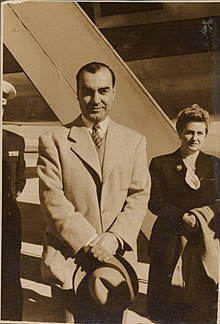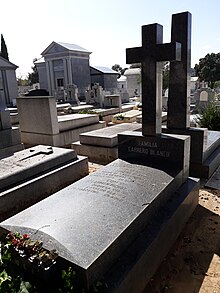Luis Carrero Blanco
Luis Carrero Blanco (Santoña, March 4, 1904 - Madrid, December 20, 1973), 1st Duke of Carrero Blanco and grandee of Spain, was a Spanish soldier and politician. A sailor by profession, he dedicated himself to a military career from his youth. He developed his career in the Navy, in which he would rise to the rank of admiral; he took part in the spanish civil war, during which he commanded several units and became chief of operations of the army general staff in august 1939.
Once the war was over, during the Franco dictatorship he went on to occupy positions of responsibility within the administration. Franco's trusted figure, she soon became his right hand. From his position as Undersecretary of the Presidency, he held a key position, acting as Franco's own collaborator and intervening in internal cabinet conflicts against other political factions. He came to be considered the second most powerful man within the dictatorship. As a consequence of this, Carrero Blanco would end up succeeding him as President of the Government. He held the head of government during the final stage of the dictatorship until his assassination carried out by ETA during the so-called "Operation Ogre".
Biography
Origins
He was born in Santoña on March 4, 1904. Descendant of a military family, since his father and grandfather belonged to the army, he was the first son of Camilo Carrero Gutiérrez (1879-1936), lieutenant colonel of the army born in La Coruña and stationed in Santander, and Ángeles Blanco Abascal (1885-1910), a native of Santoña. His grandfather Camilo Carrero Senra was a native of Orense and reached the rank of colonel.
Training and early years
He studied at the Colegio Manzanedo de Santoña and entered the Naval School of San Fernando in 1918. Between 1920 and 1921 he made his internship trip to South America on the cruise ship Reina Regente, and took part in the Rif War (1924-1926). In 1935 he was appointed professor at the Madrid Naval War College.
He went through the following destinations:
- Warehouse Officer Alfonso XIII.
- Second Coast Guard Commander Arcila.
- Captain of the tugboat Ferrolano.
- Gunship Lieutenant Cánovas del Castillo.
- Second submarine commander B-2.
- Destroyer Commander Huesca.
- Officer in the submarine General Sanjurjo.
- Chief of Staff of the Cruises Division.
- Chief of Operations of the Army Staff.
At the beginning of the Spanish Civil War, he was a professor of submarine tactics at the Naval War College in Madrid.[citation required] He took refuge in the embassies of Mexico and France, until he managed to cross over to France, to later enter the rebel zone in July 1937. With the rank of Lieutenant Commander, he was placed in command of the destroyer Huesca[citation required] and, later, of the submarine General Sanjurjo. In October 1938 he left command of the submarine and embarked on the Canarias as chief of staff of the cruiser division, a role he held until the end of the war.[citation needed]
Political career
In August 1939 he became Chief of Operations of the Army General Staff. Carrero, who had met Pedro Gamero del Castillo in 1938, was appointed thanks to the support of this national adviser to FET de las JONS in September 1939. As chief of Operations of the Navy General Staff, and at the request of the minister de Marina Salvador Moreno Fernández, wrote a famous report in 1940 recommending Spanish neutrality in World War II. The minister showed this report to Franco, who was so impressed that he made Carrero his trusted man ever since, displacing gradually to Juan Antonio Suanzes.
He was appointed Undersecretary of the Presidency and President of the National Heritage Council (1941), Minister of the Presidency (1951) and Vice President (1957), which meant a growing increase in his specific weight in the government. In his work he tried to limit the influence of the Falangists, promoted the economic and administrative modernization of the State, although always within Francoism, and supported the planning of the monarchical succession in the figure of Juan Carlos I.
In 1945, as undersecretary of the Presidency, he advised Franco as a future plan for the dictatorship, an authoritarian-type monarchy. In 1947 he would draft the Law of Succession in the Headquarters of State, in which Spain was established as "Catholic, social and representative State" that, "according to its tradition" was "constituted as a Kingdom".
In June 1973, he was appointed president of the government, which suggested that he would become the strong man of the State after the death of the dictator and the pillar on which Francoism would be based without Franco, but his assassination on 20 December 1973 in an attack perpetrated by ETA in Madrid aborted those expectations.
Murder: Operation Ogre
The assassination of Carrero Blanco, also known by its code name "Operation Ogre", was perpetrated by the terrorist group ETA on December 20, 1973, when he was president of the government of Spain. The assassination had a profound impact on Spanish society at the time, as it was the biggest attack against the Franco dictatorship since the end of the Spanish Civil War in 1939.
The disappearance of Carrero Blanco had numerous political implications, at a time when the physical decadence of the dictator was becoming evident and with it, the aggravation of the first signs of decomposition of the Francoist apparatus that had been manifesting in recent years. The most immobile sectors of Francoism, the so-called "búnker", emerged reinforced from this event and managed to influence Franco to appoint a member of the hard line, Carlos Arias Navarro, as Carrero's successor. For its part, with this attack the terrorist organization ETA made a qualitative leap in its armed actions and thus became one of the main actors in the opposition to Francoism.
The dictatorship granted him, posthumously, the title of Duke of Carrero Blanco.
Despite the fact that the authorities launched an investigation to clarify the facts, the case was shelved at the beginning of the Transition and the circumstances were never fully clarified. The perpetrators of the attack were not tried for these events either and after Franco's death they would fully benefit from the amnesty granted in 1977.
The complexity of the attack and its proximity to the United States Embassy led to the suspicion that other organizations might be involved, with the CIA and its head of stay in Spain Luis M. González-Mata Lledó, among the most mentioned, which was denied by the perpetrators of the attack.
In 2008, a note from the United States Embassy in Madrid to the State Department of the United States Government was declassified, stating that «The best result that could arise... would be for Carrero to disappear scene, with possible replacement by General Díez Alegría or Castañón».
The only person who supposedly saw the face of the man known as the "man in the white raincoat" who delivered the schedules and routes of Carrero Blanco, at the Mindanao hotel in Madrid, was José Miguel Beñarán Ordeñana, Argala, who died in 1978 at the hands of a far-right terrorist organization, the Spanish Basque Battalion.
Ideology and political positions
Not belonging to any family of the dictatorship, his identification was with the work of Franco himself, and he could be considered a pure Francoist.
A fundamentalist Catholic imbued with a radical anti-Semitism, he considered the Reform, the Encyclopedia, atheism, liberalism, leftism, Freemasonry, Marxism, communism, separatism, internationalism, as tools that were used to «destroy, annihilate and degrade everything that Christian Civilization represents, to build on its ruins the utopian Zionist Empire of the Chosen People". Openly Germanophile during the first part of World War II in his articles in the magazine Mundo, after the change of trend in the conflict against the Axis forces in 1943, he modulated his hostile discourse towards the allied powers in these publications; finally, after the defeat of the Axis, he had replaced the message against the liberal democracies with an anti-Soviet one. Fascist paganism, especially the Nazi, nor with the Falange, but he hated the liberal, democratic and working-left forces much more."
Defender of the idea that the victory of the Francoist side in the Spanish civil war would have occurred despite an alleged international conspiracy against him, years later, in the 1950s, he would insist: «This is precisely the Spanish problem, Spain wants to implant good, and the forces of evil, unleashed by the world, try to prevent it. "
Carrero, who harbored a paternalistic vision when it came to positively assessing the Spanish presence in Africa, was reluctant to accept the decolonization process. He maintained that Western Sahara "was never dominated by the Moroccan empire" and that it was "as much Spanish territory as the province of Cuenca".
Juan Luis Cebrián described Carrero's political ideology in the following terms:
Obsessed the same by Marxism that by Judaism and Freemasonry, the enemy of liberalism and democracy, Carrero seemed a man of a great simplicity of ideas, fit to be managed by those who knew how to vibrate in him the topical efusions of the homeland and religion. His vital modesty earned him honest fame, and there is still one who qualifies him as not ambitious, despite the evidence of his unmovability in power for more than thirty years. In the eyes of the new Spanish society, which fought in the early 1970s for freeing itself from the anchors of the civil war, it was the main enemy of any possible democratizing reform and the most genuine valedor of Franco's post- Franco Franco Franco Franco Franco Franco franc.
A similar portrait is the one made by Antonio Elorza:
Carrero's own thing is the counterrevolution, the anti-communism to the extreme, the satanization of the masonry, according to a conspiracy of history in which the infernal forces try to impose themselves until the appearance of a saviour crusade like the one headed by Franco: "The devil inspired man the towers of Babel from liberalism and socialism, with his own way of penetrating Marxism."
Until the end of his days he was hostile to liberal democracy. On March 1, 1973, in his speech to the National Council of the Movement, he made a program statement in which, reiterating his unconditional support for the Caudillo, his proposal to increase the political participation of citizens, had as its starting point eliminating all masking of divisive partisanship.
Works
- The victory of the Christ of Lepanto
- Military naval artI take second. The warship (from the galley to the aircraft carrier).
- Spain and the sea, National Editor, 1941.
- Lepanto (1571–1971), Salvat Editorial/Alianza Editorial, 1971.
- Under the pseudonym of Juan de la Cosa
- Comments from a Spanish. The tribulations of Don Prudencio. Underground diploma.
- The great Soviet bazaa.
- The Komsomol Doctrines.
- Gibraltar.
- Spain to the world (process of isolation), Spanish Publications, 1975.
- The Modern Towers of Babel.
Acknowledgments
- Commenced with Plaque of the Great Imperial Order of Red Arrows (1939)
- Grand Cross of the Order of Isabella the Catholic (1942).
- Grand Cross of the Naval Merit with white distinction (1943)
- Grand Officer of the Order of Africa (1961).
- Grand Cross (white distinction) of the Military Merit Order (1963).
- Grand Cross (with white distinction) of the Order of Aeronautical Merit (1967).
- Gran Cruz de la Real y Muy Distinguida Orden de Carlos III (1970).
- Great Necklace of the Order of Cisneros (1970).
Contenido relacionado
Erich von Däniken
Battle of Roncesvalles
Parthenon




